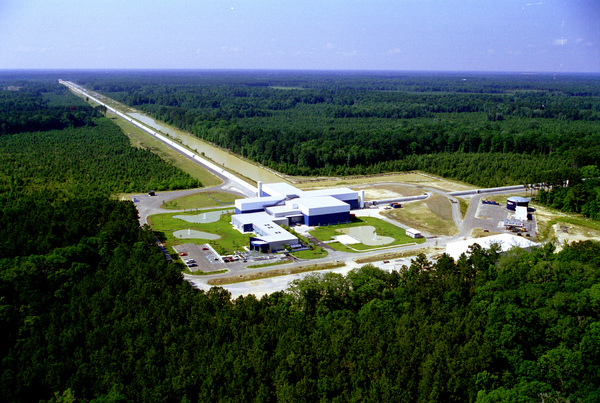
Our Australia Telescope Compact Array at Narrabri, NSW - Searching the heavens at dusk.
Our Australia Telescope Compact Array at Narrabri, NSW – Searching the sky at dusk.
Gravitational waves – ripples in space-time produced by massive, accelerating bodies like orbiting black holes or neutron stars – were predicted by Albert Einstein a century ago and first observed in 2015. That detection, of a pair of merging black holes, recently netted the 2017 Nobel Prize in Physics.
Today’s news that a fifth gravitational wave event has been detected by the international LIGO-Virgo team adds crucial new details to our understanding of the Universe. Telescopes around the world made follow-up observations of this latest event and, for the first time, detected electromagnetic radiation – gamma-rays, light, radio waves and more – along with the gravitational waves.
An Australian group led by Associate Professor Tara Murphy from the University of Sydney and the ARC Centre of Excellence for All-sky Astrophysics used our Australia Telescope Compact Array near Narrabri in NSW to confirm radio-wave emission from a gravitational wave event discovered on 17 August this year. Their research is published today in the journal Science.
This is significant because it allows astronomers to determine where the gravitational-wave event took place. Professor Murphy’s team has used more than 40 hours of observing time on the Compact Array over several weeks. Thanks to the telescope’s ‘Target of Opportunity’ system, once alerted to the gravitational-wave event the team was able to quickly gain permission to override scheduled observations and begin using the telescope as soon as the source had risen in the sky above Australia.

Aerial image of one of the unique L-shaped LIGO Observatories in the US – the Livingston Detector Site. Image: altech MIT LIGO Lab
Aerial image of one of the unique L-shaped LIGO Observatories in the US – the Livingston Detector Site. Image: altech MIT LIGO Lab
The observations suggest that the event that created the gravitational waves was the merger of two neutron stars on the outskirts of the galaxy NGC 4993, about 130 million light-years away. Douglas Bock, Director of our Astronomy and Space Science, said this extraordinary detection by an Australian team, using Australian facilities, made a significant contribution to the global discovery.
“Running a national facility involves providing researchers with access – fast – so they can monitor unexpected astronomical events of extraordinary scientific interest,” Douglas said.
The radio source has remained and will continue to be monitored. How much it strengthens and when it reaches peak strength will allow astronomers to better understand the physics of the event. The LIGO team’s detection of gravitational waves – now totalling five separate events – was made possible by thousands of international researchers who’ve contributed to the project, including our own.

LIGO technician inspecting one of LIGO’s core optics (mirrors) by illuminating its surface with light at a glancing angle. Image: Matt Heintze Caltech MIT LIGO Lab
LIGO technician inspecting one of LIGO’s core optics (mirrors) by illuminating its surface with light at a glancing angle. Image: Matt Heintze Caltech MIT LIGO Lab
Our Manufacturing team was responsible for coating many of the optics used in the ‘Advanced LIGO’ instrumentation including ultra-high performance optical mirrors to give the required reflective properties and thermal shielding. We continue to be one of the only research groups in the world able to deliver to this level of precision.
Of these latest achievements, our Chief Executive Larry Marshall said “This landmark discovery is an excellent example of the breakthroughs that can be achieved when great minds and organisations unite.
“As Australia’s national science agency we are proud to have delivered the unique optics that helped enable the original discovery, and are excited to continue supporting the global community through the delivery of excellent science and world-class facilities like the Compact Array whose applications are as unlimited as space itself.”
Want to know about our place in space?
We’re working on the latest radio astronomy research, observing Earth from above, supporting data and manufacturing supply chains, and more.


Pingback: Global collaboration is making waves in space – MeasurementDataBases for Industry & Science